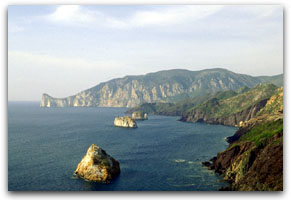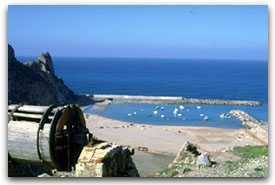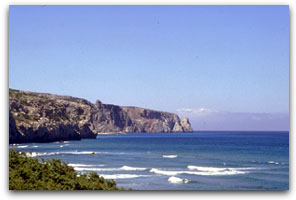Leaving the island of S. Pietro
one soon arrives at Portoscuso (another
place known for tuna fishing) and Capo Altano, where
the western coast of Sardinia starts. Most of this coast is rocky, has little shelter and is
exposed to the strong North-North/West winds that over thousands of years have moulded it.
As it is so windy, this stretch of the Sardinian coast is the least popular among sailors. It is
not however in any way an unattractive coast, on the contrary it is able to evoke strong
emotions and sensations in those who love the sea and nature. Along this coast it is
possible to enjoy perfect peace or choose a deserted bay where one can cast one's line or
if one is so inclined, dive off a secluded cliff.
|

 Nebida - Pan di zucchero Nebida - Pan di zucchero |
|
This sea is often choppy, as the
waves are driven by the winds, but it also has large unexplored sea beds that drivers and
photographers can enjoy. The coast of Nebida and Masua is wild and staggeringly beautiful,
with rock cliffs, that pay testimony to the existence of centuries of mining. There is a great
sharp rock, that rises from the sea like a mushroom from the land and is
called "Pan di Zucchero" ( Zucchero means sugar in Italian) because of its
snow-white colour.
|
Some miles further on, there is
Cala Domestica, one of the pearls of this part of the Sardinian coast. It is situated at the end
of a fjord, the entrance to which is overlooked from on high by a beautiful Aragonese
tower. After the small beach of Cala Domestica, there are rocks and deep sea as far as the
port of Buggerru (pronounced boo jair u) which
is the first harbour one meets.
|
|

 Buggerru - Il porto Buggerru - Il porto |

 The coast of Buggerru The coast of Buggerru |
|
One can see mining tunnels
carved into the mountains and ancient settlements which seem destined to
remain "industrial archaeology". Buggerru (a typical example of a Sardinian mining village)
has had to look to tourism for its future. There is an evocative stone sculptured monument
near the port dedicated to the victims of the early Trade Union movement who died in
1904.
|
|